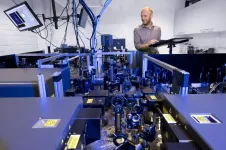(Press-News.org) Just as James Cameron's Terminator-800 was able to discriminate between "clothes, boots, and a motorcycle", machine-learning could identify different areas of interest on 2D materials.
The simple, automated optical identification of fundamentally different physical areas on these materials (eg, areas displaying doping, strain, and electronic disorder) could significantly accelerate the science of atomically-thin materials.
Atomically-thin (or 2D) layers of matter are a new, emerging class of materials that will serve as the basis for next-generation energy-efficient computing, optoelectronics and future smart-phones.
"Without any supervision, machine-learning algorithms were able to discriminate between differently perturbed areas on a 2D semiconducting material," explains lead author Dr Pavel Kolesnichenko. "This can lead to fast, machine-aided characterization of 2D materials in the future, accelerating application of these materials in next-generation low-energy smart-phones."
AUTOMATION OPENING UP THE FIELD OF ATOMICALLY-THIN MATERIALS
After the 2004 success of a single layer of pencil's graphite (graphene) as a wonder semi-metallic material with many peculiar properties, scientists around the world realized that other layered materials can also be thinned down to a single layer (a 'monolayer').
Since then, dozens of other monolayers have been obtained, including metals, semiconductors, insulators, and more-exotic quantum materials such as topological-insulators, superconductors and ferromagnets.
Having this monolayer-zoo at their disposal, materials scientists have used them like 'LEGO'-blocks: for example stacking them in many different combinations to construct next-generation transistors, batteries, memory cells and photodiodes.
All these devices, however, have been assembled manually and exist as one-off prototypes. There is still a long way towards their industrial-scale production and commercialisation.
Several factors contribute to the hindrance of the progress. First is the lack of full control over the fabrication of monolayer materials. In addition, current characterisation techniques are complicated and require the eye of an experienced researcher. Finally, due to the extreme thinness of the materials, the latter are extremely sensitive to various perturbations, many of which are introduced unintentionally. Understanding these perturbations is a non-trivial task, as they can have a combined effect and have to be disentangled.
Dr Pavel Kolesnichenko and Prof Jeffrey Davis (Swinburne University of Technology) realized that the ungrateful task of characterization of 2D materials could be accomplished by machines in a rapid and automated manner.
"In order to understand the impact of different perturbations and minimise or control their presence, it is important to be able to identify them and their spatial distribution rapidly and reliably," said Prof Davis, who is a chief investigator in ARC Centre of Excellence in Future Low-Energy Electronics Technologies (FLEET).
Working with FLEET colleague Prof Michael Fuhrer (Monash University), they applied unsupervised machine-learning algorithms to characterize the semiconducting monolayer of tungsten disulphide. The data was acquired by simple apparatus involving a microscope and a spectrometer. The learning algorithms then were able to discriminate between the areas on a monolayer flake affected by doping, strain, disorder, and the presence of additional layers.
This is the first time such a systematic disentanglement of these perturbations has been performed.
The task was accomplished by embedding the acquired data into an artificially constructed multi-dimensional parameter space. Learning algorithms were then allowed to find a way to visualize the data in comprehensible two dimensions and in the most representative way, where each perturbation formed its own data-cluster.
The team built on previous scientific results in the field including their previous publication, where they disentangled perturbations using correlated photoluminescence and absorption spectra.
"So many factors can affect optoelectronic properties of 2D materials, including the type of substrate, additional doping, strain, the presence of wrinkles, defects, and environmental molecules - you name it," said Dr Pavel Kolesnichenko (now a postdoc at Lund University). "Thus, moving to a multi-dimensional parametric space seemed to be a natural next step."
"We also hope the research will motivate scientists to apply similar ideas to other 2D materials and using other imaging modalities," says Pavel.
In the era of data-driven science and technology, the authors hope that their research will motivate the creation of a large labelled dataset, where labels (such as 'doping', 'strain', etc) would be assigned by experienced researchers. This dataset would be then used to train deep neural networks to characterize 2D materials in a fraction of a second. The researchers believe that their work will help to introduce standards for characterisation of monolayer matter, approaching the moment of large-scale use of low-energy smart-phones and computers in the future.
INFORMATION:
THE STUDY
"Multidimensional Analysis of Excitonic Spectra of Monolayers of Tungsten Disulphide: Towards Computer Aided Identification of Structural and Environmental Perturbations of 2D Materials" was published in Machine Learning: Science and Technology in February 2021. (DOI: 10.1088/2632-2153/abd87c)
"Disentangling the effects of doping, strain and disorder in monolayer WS2 by optical spectroscopy" was published in 2D Materials in January 2020. (DOI: 10.1088/2053-1583/ab626a)
While consumers look out for the Dolphin Safe mark on seafood purchases, a major research stocktake of Australian-New Zealand waters gives new guidelines to managers of dolphin fisheries.
The extensive new genomic study of almost 500 common dolphins (Delphinus delphis), spanning multiple spatial areas of more than 1500 sq km from the southern and east coast of Australia to Tasmania and New Zealand, calls for greater collaboration between the two countries' conservation and fisheries plans.
Just published in Frontiers in Marine Science, the study of DNA diversity of several dolphin populations in Australia and NZ suggests connectivity between ...
Care homes are at high risk of experiencing outbreaks of COVID-19, the disease caused by SARS-CoV-2. Older people and those affected by heart disease, respiratory disease and type 2 diabetes - all of which increase with age - are at greatest risk of severe disease and even death, making the care home population especially vulnerable.
Care homes are known to be high-risk settings for infectious diseases, owing to a combination of the underlying vulnerability of residents who are often frail and elderly, the shared living environment with multiple ...
As odd as it sounds, many scientists have attempted to place extremely small diamonds inside living cells. Why? Because nanodiamonds are consistently bright and can give us unique knowledge about the inner life of cells over a long time. Now physics researchers at Lund University in Sweden have succeeded in injecting a large number of nanodiamonds directly to the cell interior.
Diamonds are not only sought after for their beauty, but also for their uniquely luminescent properties, at least among scientists. Unlike other fluorescent materials, they do not bleach.
"We actually think of them as a dye. In addition, they are biocompatible", says Elke Hebisch, researcher at solid state physics at Lund University.
Together ...
European Union law rules that Member States must provide fair and appropriate compensation for victims of sexual offences. In some countries, few victims receive any financial compensation, or often the amount received is very low. According to figures from the Spanish Government's Ministry of Finance, obtained by professor of Criminal Law at the UOC, Josep M. Tamarit, between 1998 and 2018 in Spain some 1,356 applications for public compensation were made, of which 272 were favourably settled. "During these two decades, only 20% of the compensation ...
A team of scientists has, for the first time, identified landfalls of tropical cyclones (TCs) in Japan for the period from 1877 to 2019; this knowledge will help prepare for future TC disasters.
In recent years strong TCs have been making landfalls in Japan, such as Typhoon Jebi in 2018, which severely hit the Kinki region, and Typhoon Hagibis in 2019, which severely hit eastern Japan. While Japan has suffered from a number of TC impacts throughout its history, meteorological data for these events has been sparse.
The team, including Specially Appointed Associate Professor Hisayuki Kubota of the Faculty of ...
While the digitization process offers an extensive list of opportunities, it also presents a number of challenges for higher education institutions, a primary one of which is learner authentication in online education. More and more higher education establishments are making use of digital learning environments (DLE), and electronic assessment systems are now an increasingly important element in the digital age, both for academic institutions and for students, including those with special educational needs and disabilities (SEND).
David Bañeres is a researcher with the IN3 SOM Research Lab group and professor at the Faculty ...
Climate experts have revealed that rising temperatures will intensify future rainfall extremes at a much greater rate than average rainfall, with largest increases to short thunderstorms.
New research by Newcastle University has shown that warming temperatures in some regions of the UK are the main drivers of increases in extreme short-duration rainfall intensities, which tend to occur in summer and cause dangerous flash flooding.
These intensities are increasing at significantly higher rates than for winter storms. A study, led by Professor Hayley Fowler, of Newcastle University's School of Engineering, highlights the urgent need for climate change adaptation measures as heavier short-term rainfall increases ...
As is sensed in our daily life, jiaozi frozen in domestic refrigerator tastes less delicious than an instant frozen one sold in the supermarket. The formation of the ice crystal is to blame. In scientific researches ranging from aerospace to biology and medicine, the formation, growth and elimination of the ice crystal are of significant importance.
By far, slow freezing and vitrification are generally adopted for cryopreservation. The former method, assembling freezing jiaozi with domestic refrigerator, is accompanied by mass formation of ice crystal which inevitably does irreversible damage to the cell. Vitrification effectively avoids former problems but requires either extremely rapid freezing rate which is too hard to achieve or high ...
A research team of pharmacists at the University of Bonn has discovered two families of active substances that can block the replication of the SARS-CoV-2 coronavirus. The drug candidates are able to switch off the the key enzyme of the virus, the so-called main protease. The study is based on laboratory experiments. Extensive clinical trials are still required for their further development as therapeutic drugs. The results have now been published in the journal Angewandte Chemie.
In order for the SARS-CoV-2 coronavirus to replicate, it relies on the main protease as a key enzyme. The virus ...
For women who had participated in both of their previous two screening examinations, the incidence of breast cancers proving fatal within 10 years of diagnosis was 50 per cent lower than in women who did not attend either of the last two screening examinations. Compared with women who attended only one of the two previous screens, women who attended both had a significant 22-33 per cent reduction in breast cancer mortality.
Lead author, Professor Stephen Duffy of Queen Mary University of London, said: "While there is ample evidence that breast cancer mortality is reduced in those who attend screening, these results demonstrate that repeated attendance ...




